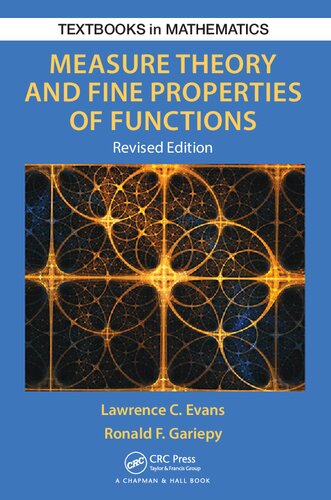

Most ebook files are in PDF format, so you can easily read them using various software such as Foxit Reader or directly on the Google Chrome browser.
Some ebook files are released by publishers in other formats such as .awz, .mobi, .epub, .fb2, etc. You may need to install specific software to read these formats on mobile/PC, such as Calibre.
Please read the tutorial at this link. https://ebooknice.com/page/post?id=faq
We offer FREE conversion to the popular formats you request; however, this may take some time. Therefore, right after payment, please email us, and we will try to provide the service as quickly as possible.
For some exceptional file formats or broken links (if any), please refrain from opening any disputes. Instead, email us first, and we will try to assist within a maximum of 6 hours.
EbookNice Team

Status:
Available4.4
39 reviews
ISBN 10: 0429161484
ISBN 13: 9781482242393
Author: Ronald F Gariepy, Lawrence C Evans
Chapter 1. General Measure Theory
1.1 Measures and measurable functions
1.1.1 Measures
1.1.2 Systems of sets
1.1.3 Approximation by open and compact sets
1.1.4 Measurable functions
1.2 Lusin’s and Egoroff’s Theorems
1.3 Integrals and limit theorems
1.4 Product measures, Fubini’s Theorem, Lebesgue measure
1.5 Covering theorems
1.5.1 Vitali’s Covering Theorem
1.5.2 Besicovitch’s Covering Theorem
1.6 Differentiation of Radon measures
1.6.1 Derivatives
1.6.2 Integration of derivatives; Lebesgue decomposition
1.7 Lebesgue points, approximate continuity
1.7.1 Differentiation Theorem
1.7.2 Approximate limits, approximate continuity
1.8 Riesz Representation Theorem
1.9 Weak convergence
1.9.1 Weak convergence of measures
1.9.2 Weak convergence of functions
1.9.3 Weak convergence in L^1
1.9.4 Measures of oscillation
1.10 References and notes
Chapter 2. Hausdorff Measures
2.1 Definitions and elementary properties
2.2 Isodiametric inequality, H^n = L^n
2.3 Densities
2.4 Functions and Hausdorff measure
2.4.1 Hausdorff measure and Lipschitz mappings
2.4.2 Graphs of Lipschitz functions
2.4.3 Integrals over balls
2.5 References and notes
Chapter 3. Area and Coarea Formulas
3.1 Lipschitz functions, Rademacher’s Theorem
3.1.1 Lipschitz continuous functions
3.1.2 Rademacher’s Theorem
3.2 Linear maps and Jacobians
3.2.1 Linear mappings
3.2.2 Jacobians
3.3 The area formula
3.3.1 Preliminaries
3.3.2 Proof of the area formula
3.3.3 Change of variables formula
3.3.4 Applications
3.4 The coarea formula
3.4.1 Preliminaries
3.4.2 Proof of the coarea formula
3.4.3 Change of variables formula
3.4.4 Applications
3.5 References and notes
Chapter 4. Sobolev Functions
4.1 Definitions and elementary properties
4.2 Approximation
4.2.1 Approximation by smooth functions
4.2.2 Product and chain rules
4.2.3 W^{1, ∞} and Lipschitz continuous functions
4.3 Traces
4.4 Extensions
4.5 Sobolev inequalities
4.5.1 Gagliardo–Nirenberg–Sobolev inequality
4.5.2 Poincaré’s inequality on balls
4.5.3 Morrey’s inequality
4.6 Compactness
4.7 Capacity
4.7.1 Definitions and elementary properties
4.7.2 Capacity and Hausdorff dimension
4.8 Quasicontinuity, precise representatives of Sobolev functions
4.9 Differentiability on lines
4.9.1 Sobolev functions of one variable
4.9.2 Differentiability on a.e. line
4.10 References and notes
Chapter 5. Functions of Bounded Variation, Sets of Finite Perimeter
5.1 Definitions, Structure Theorem
5.2 Approximation and compactness
5.2.1 Lower semicontinuity
5.2.2 Approximation by smooth functions
5.2.3 Compactness
5.3 Traces
5.4 Extensions
5.5 Coarea formula for BV functions
5.6 Isoperimetric inequalities
5.6.1 Sobolev’s and Poincaré’s inequalities for BV
5.6.2 Isoperimetric inequalities
5.6.3 H^{n−1} and Cap_1
5.7 The reduced boundary
5.7.1 Estimates
5.7.2 Blow-up
5.7.3 Structure Theorem for sets of finite perimeter
5.8 Gauss–Green Theorem
5.9 Pointwise properties of BV functions
5.10 Essential variation on lines
5.10.1 BV functions of one variable
5.10.2 Essential variation on almost all lines
5.11 A criterion for finite perimeter
5.12 References and notes
Chapter 6. Differentiability, Approximation by C^1 Functions
6.1 L^p differentiability, approximate differentiability
6.1.1 L^1^∗ differentiability for BV
6.1.2 L^p^∗ differentiability a.e. for W^{1, p}
6.1.3 Approximate differentiability
6.2 Differentiability a.e. for W^{1, p} (p > n)
6.3 Convex functions
6.4 Second derivatives a.e. for convex functions
6.5 Whitney’s Extension Theorem
6.6 Approximation by C^1 functions
6.6.1 Approximation of Lipschitz continuous functions
6.6.2 Approximation of BV functions
6.6.3 Approximation of Sobolev functions
6.7 References and notes
measure theory and fine properties of functions
measure theory in physics
measure theory in finance
measure theory vs real analysis
three measures of fine meal
what is measure in measure theory
Tags: Ronald F Gariepy, Lawrence C Evans, Measure